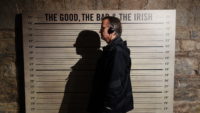 We like to make connections when we travel (and in general, actually). Meredith has had much fun this trip being in places where things happened that relate to what she has been teaching regarding literature during England’s Restoration Period (and on into the eighteenth century), when the monarchy was restored after Cromwell’s Commonwealth (which lasted about twelve years). Since Ireland was deeply affected by events surrounding this time (Cromwell is still reviled in parts of Ireland for his brutality), things pop up related to what Mer has been covering in class.
We like to make connections when we travel (and in general, actually). Meredith has had much fun this trip being in places where things happened that relate to what she has been teaching regarding literature during England’s Restoration Period (and on into the eighteenth century), when the monarchy was restored after Cromwell’s Commonwealth (which lasted about twelve years). Since Ireland was deeply affected by events surrounding this time (Cromwell is still reviled in parts of Ireland for his brutality), things pop up related to what Mer has been covering in class.
Today, we toured Trinity College, where Samuel Johnson got an honorary doctorate; he was also Mer’s featured author for the eighteenth century. The other day we were in Kilkenny, where Cromwell’s army damaged the castle wall; Mer had just finished teaching about Cromwell and the Restoration as background for the literature the class was reading. The connections come up when you travel in English-speaking countries and you teach English.
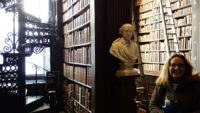 Back to Trinity. We took an actual student-led tour instead of a self-guided tour. We tend to find guides much more interesting. We were led around campus by a woman from India who was about to finish up her master’s degree. We learned several things over the hour we were with her:
Back to Trinity. We took an actual student-led tour instead of a self-guided tour. We tend to find guides much more interesting. We were led around campus by a woman from India who was about to finish up her master’s degree. We learned several things over the hour we were with her:
– Trinity admitted women around 1900, and now sixty percent of the student body is women
– Only a thousand of the eighteen thousand students can live on campus – the rest have to find housing, which is difficult in Dublin right now
– The oldest buildings date back to the 1700s
– One building was made entirely of Irish materials, and the carvings on the building are all of Irish flora and fauna
– There are six libraries, and the best-known one (where the Book of Kells is housed) is about to undergo a three-year renovation to make it safer for the rare books housed inside
 After the tour, we did get into the library to see the Book of Kells. Mer and I both remember it being in a display case on a counter in the main library. That is not the situation anymore – there is an anteroom where you learn about other illustrated manuscripts and how the Book of Kells was made. I was amazed it survived – the abbey in which it was housed was raided by pillagers several times, and fires seemed to break out every few years (the boards just listed ten or so years and ended with ellipses…). The book itself is in a huge case all alone in a twenty-by-twenty room. It was opened to a page of mostly text, with just a few individual letters being illustrated. It was subtle enough that Mer thought it was a different old manuscript and had to go back to see it when I pointed out it really was the Book of Kells.
After the tour, we did get into the library to see the Book of Kells. Mer and I both remember it being in a display case on a counter in the main library. That is not the situation anymore – there is an anteroom where you learn about other illustrated manuscripts and how the Book of Kells was made. I was amazed it survived – the abbey in which it was housed was raided by pillagers several times, and fires seemed to break out every few years (the boards just listed ten or so years and ended with ellipses…). The book itself is in a huge case all alone in a twenty-by-twenty room. It was opened to a page of mostly text, with just a few individual letters being illustrated. It was subtle enough that Mer thought it was a different old manuscript and had to go back to see it when I pointed out it really was the Book of Kells.
The Old Library main hall is special. It is what a library should look like – lots of wood, space, busts of great thinkers, and shelves and shelves of books. It was quite a sight to see. And oddly, it dumped us out into a gift shop.
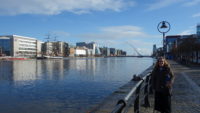 After Trinity, we split up – Neuf, Regina, and Shelby went off to see 14 Henrietta Street, a house museum about tenement life in Dublin. Mer and I walked over to the EPIC Emigration Museum, which is fairly new, having opened around 2016. It was founded by an Irish emigrant who managed to do okay by becoming the CEO of Coca-Cola; he wanted to tell the story of ordinary Irish emigrants, giving the reasons they left, and the impact they have had on the world. EPIC stands for Every Person Is Connected.
After Trinity, we split up – Neuf, Regina, and Shelby went off to see 14 Henrietta Street, a house museum about tenement life in Dublin. Mer and I walked over to the EPIC Emigration Museum, which is fairly new, having opened around 2016. It was founded by an Irish emigrant who managed to do okay by becoming the CEO of Coca-Cola; he wanted to tell the story of ordinary Irish emigrants, giving the reasons they left, and the impact they have had on the world. EPIC stands for Every Person Is Connected.
The museum is largely interactive, with twenty rooms laid out in a one-way path. Each room has a theme, and you can stamp your room passport in each room. A themed, one-way museum with stamps – it’s as if it was made for Meredith. She was pretty happy.
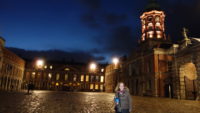 Some of the rooms gave reasons why people left (war, famine, poverty, unjust laws, etc.). Some talked about what the Irish did after they left (one room on “infamy,” where they talked about outlaws, one room on soldiering, one on discoveries and science, one on religion and social work, etc.) The room on music and dance was my favorite, while Meredith was thrilled that two whole rooms were dedicated to storytelling. In typical Riordan touring fashion, while the museum said it would take about ninety minutes to get through the rooms, we took four hours, and we even skipped some of the detailed interactive stories.
Some of the rooms gave reasons why people left (war, famine, poverty, unjust laws, etc.). Some talked about what the Irish did after they left (one room on “infamy,” where they talked about outlaws, one room on soldiering, one on discoveries and science, one on religion and social work, etc.) The room on music and dance was my favorite, while Meredith was thrilled that two whole rooms were dedicated to storytelling. In typical Riordan touring fashion, while the museum said it would take about ninety minutes to get through the rooms, we took four hours, and we even skipped some of the detailed interactive stories.
We walked back toward our hotel area, stopping at a cafe for a snack since we had missed lunch (it was after 3:00 when we left the EPIC museum). We regrouped and got more water at the hotel, before walking back to Dublin Castle to go to the Chester Beatty Museum, where we met the others.
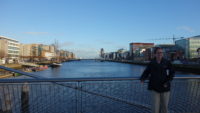 Chester Beatty was a man who made a ton of money from mining, and he was an avid collector. He sounded like a generous and open-handed man, and before he died, he built a library in Dublin to house his extensive collection – mostly Buddhist, Islamic, and Christian texts and art. The collection includes the oldest known papyrus copies of the Gospels and Paul’s letters, dating from the third century. He left everything to the Irish people on the condition that it be displayed for free (we did leave a donation).
Chester Beatty was a man who made a ton of money from mining, and he was an avid collector. He sounded like a generous and open-handed man, and before he died, he built a library in Dublin to house his extensive collection – mostly Buddhist, Islamic, and Christian texts and art. The collection includes the oldest known papyrus copies of the Gospels and Paul’s letters, dating from the third century. He left everything to the Irish people on the condition that it be displayed for free (we did leave a donation).
The five of us took a highlights tour, which mostly consisted of old manuscripts from the three religions, but did include a dragon robe that only the emperor of China could wear. It seems Beatty collected eight of these robes. There was also a cool and huge printed panorama of 1700s London, showing from Westminster all the way past St. Paul’s. I loved the Christian material, of course, but the entire collection was interesting.
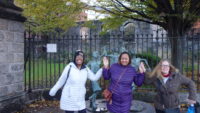 That left only supper, which we grabbed at a pub that had live music at 7:30. We stayed for over an hour, and the music was fun and entertaining, but the duo only sang a couple of Irish songs that I recognized, and neither of those were ones I knew well. I may need to try again tomorrow so I can make a better personal connection to the music.
That left only supper, which we grabbed at a pub that had live music at 7:30. We stayed for over an hour, and the music was fun and entertaining, but the duo only sang a couple of Irish songs that I recognized, and neither of those were ones I knew well. I may need to try again tomorrow so I can make a better personal connection to the music.